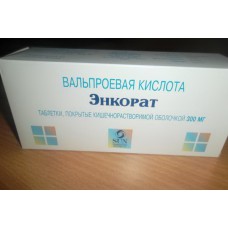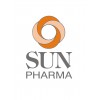Expiration date: 02/2026
Description of the active substance (INN): valproic acid
Dosage Form: tablets
Pharmachologic effect:
Antiepileptic drugs, has central muscle relaxant and sedative effect. The mechanism of action associated with increased content of GABA in the CNS (by inhibiting GABA-transferase, and a decrease GABA re-uptake in the brain), thereby reducing the anxiety and convulsive readiness motor areas of the brain. According al. Hypothesis acts on portions of postsynaptic receptors by mimicking or enhancing the inhibitory effect of GABA. Possible direct effect on the activity of the membrane due to the change in conductivity for K +. It improves mood and mental state of patients has anti-arrhythmic activity.
Indications:
Epilepsy different genesis. Epileptic seizures (including generalized and partial seizures, as well as against the background of organic brain disease). Changes in the nature and behavior (due to epilepsy). Febrile seizures (in children), children tick. Manic-depressive psychosis with bipolar course, not amenable to treatment with drugs Li + or others. PM. The specific syndromes (West, Lennox-Gastaut syndrome).
Contraindications:
Hypersensitivity, hepatic failure, acute and chronic hepatitis, disorders of the pancreas, porphyria, bleeding diathesis, severe thrombocytopenia, pregnancy (I trimester), lactation, children's age (up to 3 years, except for syrup) .C caution. Inhibition of bone marrow blood (leucopenia, thrombocytopenia, anemia), organic brain disease, liver disease and pancreatic cancer history, hypoproteinemia, mental retardation in children, congenital fermentopathy, renal failure, pregnancy.
Side effects:
CNS: tremor, rarely - changes in behavior, mood or mental state (depression, fatigue, hallucinations, aggression, hyperactivity condition, psychosis, unusual excitement, restlessness or irritability), ataxia, dizziness, drowsiness, headache, encephalopathy, dysarthria, enuresis, stupor, impaired consciousness, coma. From the senses: diplopia, nystagmus, flashing "flies" in front of his eyes. From the digestive system: nausea, vomiting, gastralgia, loss of appetite or increased appetite, diarrhea, hepatitis, and rarely - constipation, pancreatitis, down to heavy defeats fatal (in the first 6 months of treatment, often at 2-12 weeks). From the side of hematopoiesis and hemostasis system: inhibition of bone marrow hematopoiesis (anemia, leukopenia), thrombocytopenia, decreased fibrinogen and platelet aggregation, leading to the development of anticoagulation (accompanied by a lengthening of bleeding time, petechiae, bruising, hematoma, bleeding, etc.). From a metabolism: a decrease or increase in body weight. Allergic reactions: skin rash, urticaria, angioedema, photosensitivity, malignant exudative erythema (Stevens-Johnson syndrome). Laboratory findings: hypercreatininemia, hyperammonemia, giperglitsinemiya, hyperbilirubinemia, a slight increase in activity of "liver" transaminases, LDH (dose-dependent). From endocrine system: dysmenorrhea, secondary amenorrhea, breast enlargement, galactorrhea. Other: peripheral edema, alopecia.
Overdose:
Symptoms include nausea, vomiting, dizziness, diarrhea, breathing function, muscular hypotonia, hyporeflexia, miosis, coma. Treatment: gastric lavage (no later than 10-12 hours), administration of activated charcoal, forced diuresis, maintenance of vital functions, hemodialysis.
Dosage and administration:
Inside, during a meal or immediately after a meal, not liquid, squeezed small amounts of water, 2-3 times a day. The syrup may be mixed with any liquid or added to a small amount of food. The initial dose of monotherapy for adults and children weighing more than 25 kg - 5-15 mg / kg / day, then gradually increase the dose of 5-10 mg / kg / week. The maximum dose - 30 mg / kg / day (may be increased if possible oversight for the plasma concentration to 60 mg / kg / day). In combination therapy in adults - 10-30 mg / kg / day, followed by increasing doses of 5-10 mg / kg / week. Children with body weight less than 25 kg average daily dose in monotherapy - 15-45 mg / kg, the maximum - 50 mg / kg. Depending on age: newborn - 30 mg / kg, 3 to 10 years - 30-40 mg / kg / day to 1 year - in 2 hours, the older - in 3 doses. In the combination therapy - 30-100 mg / kg / day. Children with body weight less than 20 kg should not be used with controlled release tablets. In / jet at 400-800 mg or in / in the drip, at the rate of 25 mg / kg for 24, 36, 48 hours. When the decision to move to in / in the introduction, after oral administration is carried out first at a dose of 0.5-1 mg / kg / hr over 4-6 hours after the last oral administration.
Special instructions:
During treatment is appropriate control activity of "liver" transaminases, bilirubin, peripheral blood, blood platelets, blood coagulation status, amylase activity (every 3 months, especially when combined with others. Antiepileptic drugs). Patients, who receive other. Antiepileptic drugs, transfer to receiving valproic acid should be gradual, reaching a clinically effective dose in 2 weeks, after chgo possible phasing out of others. Antiepileptic drugs. Patients who did not receive treatment, etc.. Antiepileptic drugs, clinically effective dose should be achieved after 1 week. The risk of side effects from the liver increased during the combined anticonvulsant therapy, as well as in children. It is not allowed reception drinks containing ethanol. Before surgery requires complete blood count (including platelet count), the determination of bleeding time, coagulation parameters. In the event during the treatment of symptoms of "acute" abdomen prior to surgery is recommended to determine the level of amylase in the blood for elimination of acute pancreatitis. During treatment should take into account the possible distortion of the results of urine tests for diabetes mellitus (due to increased content ketoproduktov), ??indicators of thyroid function. With the development of any acute severe side effects you should immediately discuss with your doctor the advisability of continuing or stopping treatment. To reduce the risk of diarrheal illness can receive antispasmodics and envelop drugs. Sudden discontinuation of valproic acid may lead to more frequent epileptic seizures. During the period of treatment must be careful when driving and other lesson. Potentially hazardous activities that require high concentration and psychomotor speed reactions.
Interaction:
Valproic acid enhances the effects, including side, etc. antiepileptic drugs (phenytoin, lamotrigine), antidepressants, antipsychotic drugs (neuroleptics), anxiolytics, barbiturates, MAO inhibitors, timoleptikov ethanol. Adding valproate to clonazepam in rare cases can lead to increased severity of absence status. With simultaneous use of valproic acid, barbiturates or primidone there is an increase in their concentration in plasma. Increases T1 / 2 Lamotrigine (suppresses liver enzymes causes slowing metabolism of lamotrigine thereby T1 / 2 of its extended to 70 hours for adults and up to 45-55 h - children). AZT reduces clearance by 38%, while it T1 / 2 does not change. Tricyclic antidepressants, MAO inhibitors, antipsychotic drugs (neuroleptics), and others. Drugs that reduce the threshold for seizure activity, reduce the effectiveness of valproic acid. In combination with salicylates observed amplification effects of valproic acid (the displacement of its association with plasma proteins), enhances the effect of antiplatelet agents (ASA) and indirect anticoagulants. In combination with phenobarbital, phenytoin, carbamazepine, valproic acid, mefloquine reduced serum content (metabolism acceleration). Felbamate increases the concentration of valproic acid in plasma by 35-50% (required dose adjustment). With simultaneous use of valproic acid, ethanol and others. Drugs, oppressive central nervous system (tricyclics, MAO inhibitors and antipsychotic drugs) may increase CNS depression. Ethanol and others. Hepatotoxic drugs increase the likelihood of developing liver disease. Valproic acid does not cause induction of "liver" enzymes and does not reduce the effectiveness of oral contraceptives. Myelotoxic drugs - increased risk of suppression of bone marrow hematopoiesis.


